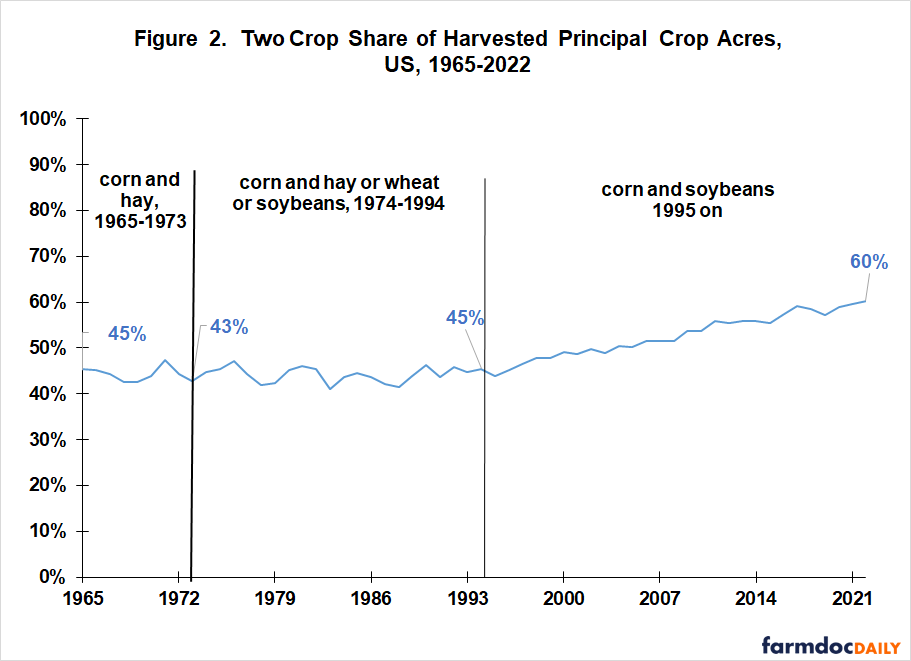Concentration of US Principal Crop Acres in Corn and Soybeans
Concern is often expressed about the loss of crop diversity in the United States. As measured by the share of harvested principal crop acres accounted for by the two US largest acreage crops, increasing concentration dates to the mid-1990s when corn and soybeans consistently became the top two acreage crops. The next article in this two-article set will explore a potential explanation for the increasing concentration of US principal crop acres in corn and soybeans and implications of this potential explanation for meeting future increases in demand.
Data
Data were obtained from the Quickstats database (US Department of Agriculture, National Agriculture Statistics Service (USDA, NASS)) for harvested corn, soybean, and principal crop acres. Principal crop acres are available electronically only for 1990-2022. Principal crop acres for 1965-1989 are from Agricultural Statistics (USDA, NASS). The initial year was chosen to be near the end of the period of fixed price supports managed by government supply control and public stock programs. Data for 2022 are estimates as of mid-August 2023.
Corn and Soybean Shares
Since 1965, corn and soybean shares of harvested principal crop acres have increased (see Figure 1). Soybean’s share increased rapidly from 1965 through 1979, going from 12% to 21%. Corn’s share in 1979 was 24%, slightly above its 22% share in 1965. Shares of both crops then remained fairly stable until resuming their increase in the late 1990s. Since 2009, corn’s share has fluctuated between 28% and 31% while soybean’s share has continued to increase. Soybean acres slightly exceeded corn acres in half of the years from 2017 through 2022.
Two Crop Share
Between 1965 and 1994, the share of harvested principal crop acres accounted for by the two largest acreage crops fluctuated between 40% and 46% (see Figure 2). Since 1994, the top two crop share has steadily increased from 45% to 60%. This is also the period when corn and soybeans have consistently been the top two acreage crops. Prior to 1974, corn and hay were the top two crops. A transition period occurred between 1974 and 1994 as the second largest acreage crop varied among hay, wheat, and soybeans.
Discussion
Concern is often expressed about the loss of cropping diversity in the US.
Increasing concentration, as measured by the share of harvested principal crop acres accounted for by the two largest acreage crops, began during the middle 1990s when corn and soybeans consistently became the two largest acreage crops in the US.
Increasing concentration coincides with the 1996 farm bill, whose freedom to plant provision removed almost all farm program constraints on farmers’ planting decisions.
It seems reasonable to hypothesize that freedom to plant has facilitated the increasing concentration of US crop agriculture in corn and soybeans.
The next article in this two-article set will explore a potential explanation for the increasing concentration in corn and soybeans as well as implications of this potential explanation for meeting future increases in demand.
Data Sources and References
US Department of Agriculture, National Agricultural Statistics Service. August 2023. QuickStats. http://quickstats.nass.U.S.da.gov/
US Department of Agriculture, National Agricultural Statistics Service. August 2023. Agricultural Statistics. 1972, 1984, and 1994. https://usda.library.cornell.edu/concern/publications/j3860694x?locale=en
Disclaimer: We request all readers, electronic media and others follow our citation guidelines when re-posting articles from farmdoc daily. Guidelines are available here. The farmdoc daily website falls under University of Illinois copyright and intellectual property rights. For a detailed statement, please see the University of Illinois Copyright Information and Policies here.









